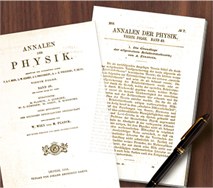General Relativity: a new theory of gravity
Texts by Dr. Antonio Moreno González
Confirmation from experiments that the speed of light in a vacuum, c --the maximum speed known to date for transmitting data--is the same for all inert observers, i.e. those for whom the principle of inertia, as formulated by Newton, is fulfilled, led Einstein to consider that the concept of simultaneity was a relative one. Furthermore, the finitude and constancy of c alters the classic notions of space and time, producing effects such as the dilation of time and the contraction of space , which increase with the velocity, and cannot be reconciled with Newtonian mechanics. Together with the discovery of the relationship between the mass and energy of a given quantity of matter, E = mc2 , these phenomena form the surprising and relevant contributions of the special or restricted theory of relativity, governed by the principle that the laws of physics, such as the speed of light, are the same for all stationary observers.
Einstein extended the special theory to accelerated movements and curved trajectories, taking as a reference planetary movement and free fall towards Earth. He thus established his general theory of relativity, essentially based on the principle of equivalence between acceleration and gravity, which he considered "the most fortunate idea of my life". It was certainly his most original idea and the one for which he finally gained the recognition of the scientific community.
Classical physics' notion of space, as a receptacle which exists regardless of whether or not is has content, and time, as an imperturbable measure of the duration of events, whatever the dynamic circumstances in which they occur, ceased to be valid. According to the general theory of relativity, space-time, as a single whole, is configured by the matter itself: a space-time described with Riemannian, rather than Euclidean, geometry. Despite the change these ideas wrought in the physics of his time, Einstein considered his theories of relativity to be "an evolution, not a revolution, in dynamics". In answer to a journalist, Einstein summarised his relativist theories as follows: "Time, space and gravity do not exist without matter".

Annalen der Physik , magazine in which Einstein published his most novel and relevant work
